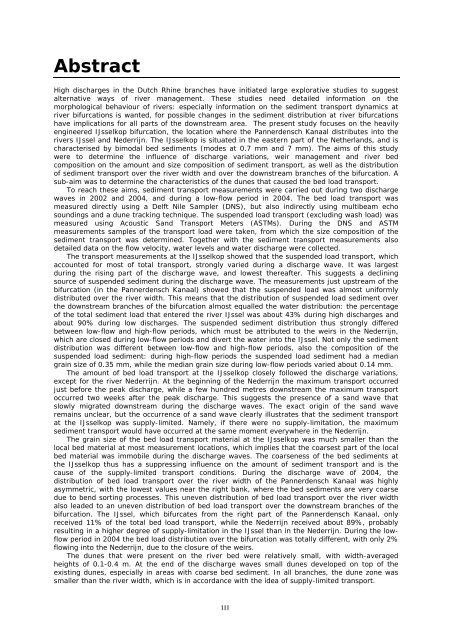Eigentijds rapport - Faculteit Geowetenschappen - Universiteit Utrecht
Eigentijds rapport - Faculteit Geowetenschappen - Universiteit Utrecht
Eigentijds rapport - Faculteit Geowetenschappen - Universiteit Utrecht
You also want an ePaper? Increase the reach of your titles
YUMPU automatically turns print PDFs into web optimized ePapers that Google loves.
Abstract<br />
High discharges in the Dutch Rhine branches have initiated large explorative studies to suggest<br />
alternative ways of river management. These studies need detailed information on the<br />
morphological behaviour of rivers: especially information on the sediment transport dynamics at<br />
river bifurcations is wanted, for possible changes in the sediment distribution at river bifurcations<br />
have implications for all parts of the downstream area. The present study focuses on the heavily<br />
engineered IJsselkop bifurcation, the location where the Pannerdensch Kanaal distributes into the<br />
rivers IJssel and Nederrijn. The IJsselkop is situated in the eastern part of the Netherlands, and is<br />
characterised by bimodal bed sediments (modes at 0.7 mm and 7 mm). The aims of this study<br />
were to determine the influence of discharge variations, weir management and river bed<br />
composition on the amount and size composition of sediment transport, as well as the distribution<br />
of sediment transport over the river width and over the downstream branches of the bifurcation. A<br />
sub-aim was to determine the characteristics of the dunes that caused the bed load transport.<br />
To reach these aims, sediment transport measurements were carried out during two discharge<br />
waves in 2002 and 2004, and during a low-flow period in 2004. The bed load transport was<br />
measured directly using a Delft Nile Sampler (DNS), but also indirectly using multibeam echo<br />
soundings and a dune tracking technique. The suspended load transport (excluding wash load) was<br />
measured using Acoustic Sand Transport Meters (ASTMs). During the DNS and ASTM<br />
measurements samples of the transport load were taken, from which the size composition of the<br />
sediment transport was determined. Together with the sediment transport measurements also<br />
detailed data on the flow velocity, water levels and water discharge were collected.<br />
The transport measurements at the IJsselkop showed that the suspended load transport, which<br />
accounted for most of total transport, strongly varied during a discharge wave. It was largest<br />
during the rising part of the discharge wave, and lowest thereafter. This suggests a declining<br />
source of suspended sediment during the discharge wave. The measurements just upstream of the<br />
bifurcation (in the Pannerdensch Kanaal) showed that the suspended load was almost uniformly<br />
distributed over the river width. This means that the distribution of suspended load sediment over<br />
the downstream branches of the bifurcation almost equalled the water distribution: the percentage<br />
of the total sediment load that entered the river IJssel was about 43% during high discharges and<br />
about 90% during low discharges. The suspended sediment distribution thus strongly differed<br />
between low-flow and high-flow periods, which must be attributed to the weirs in the Nederrijn,<br />
which are closed during low-flow periods and divert the water into the IJssel. Not only the sediment<br />
distribution was different between low-flow and high-flow periods, also the composition of the<br />
suspended load sediment: during high-flow periods the suspended load sediment had a median<br />
grain size of 0.35 mm, while the median grain size during low-flow periods varied about 0.14 mm.<br />
The amount of bed load transport at the IJsselkop closely followed the discharge variations,<br />
except for the river Nederrijn. At the beginning of the Nederrijn the maximum transport occurred<br />
just before the peak discharge, while a few hundred metres downstream the maximum transport<br />
occurred two weeks after the peak discharge. This suggests the presence of a sand wave that<br />
slowly migrated downstream during the discharge waves. The exact origin of the sand wave<br />
remains unclear, but the occurrence of a sand wave clearly illustrates that the sediment transport<br />
at the IJsselkop was supply-limited. Namely, if there were no supply-limitation, the maximum<br />
sediment transport would have occurred at the same moment everywhere in the Nederrijn.<br />
The grain size of the bed load transport material at the IJsselkop was much smaller than the<br />
local bed material at most measurement locations, which implies that the coarsest part of the local<br />
bed material was immobile during the discharge waves. The coarseness of the bed sediments at<br />
the IJsselkop thus has a suppressing influence on the amount of sediment transport and is the<br />
cause of the supply-limited transport conditions. During the discharge wave of 2004, the<br />
distribution of bed load transport over the river width of the Pannerdensch Kanaal was highly<br />
asymmetric, with the lowest values near the right bank, where the bed sediments are very coarse<br />
due to bend sorting processes. This uneven distribution of bed load transport over the river width<br />
also leaded to an uneven distribution of bed load transport over the downstream branches of the<br />
bifurcation. The IJssel, which bifurcates from the right part of the Pannerdensch Kanaal, only<br />
received 11% of the total bed load transport, while the Nederrijn received about 89%, probably<br />
resulting in a higher degree of supply-limitation in the IJssel than in the Nederrijn. During the lowflow<br />
period in 2004 the bed load distribution over the bifurcation was totally different, with only 2%<br />
flowing into the Nederrijn, due to the closure of the weirs.<br />
The dunes that were present on the river bed were relatively small, with width-averaged<br />
heights of 0.1-0.4 m. At the end of the discharge waves small dunes developed on top of the<br />
existing dunes, especially in areas with coarse bed sediment. In all branches, the dune zone was<br />
smaller than the river width, which is in accordance with the idea of supply-limited transport.<br />
III
















